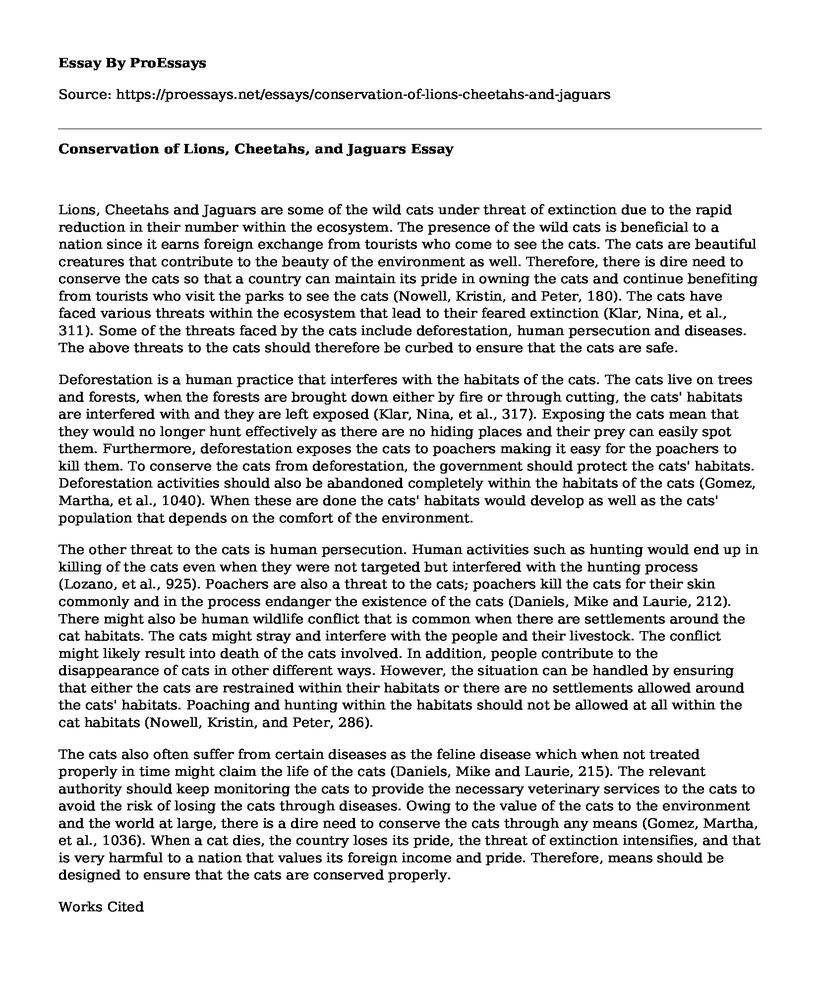Lions, Cheetahs and Jaguars are some of the wild cats under threat of extinction due to the rapid reduction in their number within the ecosystem. The presence of the wild cats is beneficial to a nation since it earns foreign exchange from tourists who come to see the cats. The cats are beautiful creatures that contribute to the beauty of the environment as well. Therefore, there is dire need to conserve the cats so that a country can maintain its pride in owning the cats and continue benefiting from tourists who visit the parks to see the cats (Nowell, Kristin, and Peter, 180). The cats have faced various threats within the ecosystem that lead to their feared extinction (Klar, Nina, et al., 311). Some of the threats faced by the cats include deforestation, human persecution and diseases. The above threats to the cats should therefore be curbed to ensure that the cats are safe.
Deforestation is a human practice that interferes with the habitats of the cats. The cats live on trees and forests, when the forests are brought down either by fire or through cutting, the cats' habitats are interfered with and they are left exposed (Klar, Nina, et al., 317). Exposing the cats mean that they would no longer hunt effectively as there are no hiding places and their prey can easily spot them. Furthermore, deforestation exposes the cats to poachers making it easy for the poachers to kill them. To conserve the cats from deforestation, the government should protect the cats' habitats. Deforestation activities should also be abandoned completely within the habitats of the cats (Gomez, Martha, et al., 1040). When these are done the cats' habitats would develop as well as the cats' population that depends on the comfort of the environment.
The other threat to the cats is human persecution. Human activities such as hunting would end up in killing of the cats even when they were not targeted but interfered with the hunting process (Lozano, et al., 925). Poachers are also a threat to the cats; poachers kill the cats for their skin commonly and in the process endanger the existence of the cats (Daniels, Mike and Laurie, 212). There might also be human wildlife conflict that is common when there are settlements around the cat habitats. The cats might stray and interfere with the people and their livestock. The conflict might likely result into death of the cats involved. In addition, people contribute to the disappearance of cats in other different ways. However, the situation can be handled by ensuring that either the cats are restrained within their habitats or there are no settlements allowed around the cats' habitats. Poaching and hunting within the habitats should not be allowed at all within the cat habitats (Nowell, Kristin, and Peter, 286).
The cats also often suffer from certain diseases as the feline disease which when not treated properly in time might claim the life of the cats (Daniels, Mike and Laurie, 215). The relevant authority should keep monitoring the cats to provide the necessary veterinary services to the cats to avoid the risk of losing the cats through diseases. Owing to the value of the cats to the environment and the world at large, there is a dire need to conserve the cats through any means (Gomez, Martha, et al., 1036). When a cat dies, the country loses its pride, the threat of extinction intensifies, and that is very harmful to a nation that values its foreign income and pride. Therefore, means should be designed to ensure that the cats are conserved properly.
Works Cited
Daniels, Mike J., and Laurie Corbett. "Redefining introgressed protected mammals: when is a wildcat a wild cat and a dingo a wild dog?." Wildlife Research 30.3 (2003): 213-218.
Gomez, Martha C., et al. "Nuclear transfer of synchronized African wild cat somatic cells into enucleated domestic cat oocytes." Biology of reproduction 69.3 (2003): 1032-1041.
Klar, Nina, et al. "Habitat selection models for European wildcat conservation." Biological Conservation 141.1 (2008): 308-319.
Lozano, J., et al. "Importance of scrubpastureland mosaics for wild-living cats occurrence in a Mediterranean area: implications for the conservation of the wildcat (Felis silvestris)." Biodiversity & Conservation 12.5 (2003): 921-935.
Nowell, Kristin, and Peter Jackson, eds. Wild cats: status survey and conservation action plan. Gland: IUCN, 2011, (1-382).
Cite this page
Conservation of Lions, Cheetahs, and Jaguars. (2021, Mar 08). Retrieved from https://proessays.net/essays/conservation-of-lions-cheetahs-and-jaguars
If you are the original author of this essay and no longer wish to have it published on the ProEssays website, please click below to request its removal:
- Biological Basis of Genetically Modified Crop Plants Essay
- Paper Example on Banning Horse-Drawn Carriages From the Street of New York City
- Water Pollution and Human Health - Article Analysis Essay
- Oil Sands, Keystone XL Pipeline: Environmental Issues & Impact - Essay Sample
- Essay Example on Natural Gas: Captured Carbon Degraded and Stored in Earth's Crust
- The Caribbean Sea: Pollution From Industrialization, Globalization, & Urbanization - Essay Sample
- Environmental Health: Assessing Human Health and Disease Risk From Climate and Built Environments - Essay Sample







